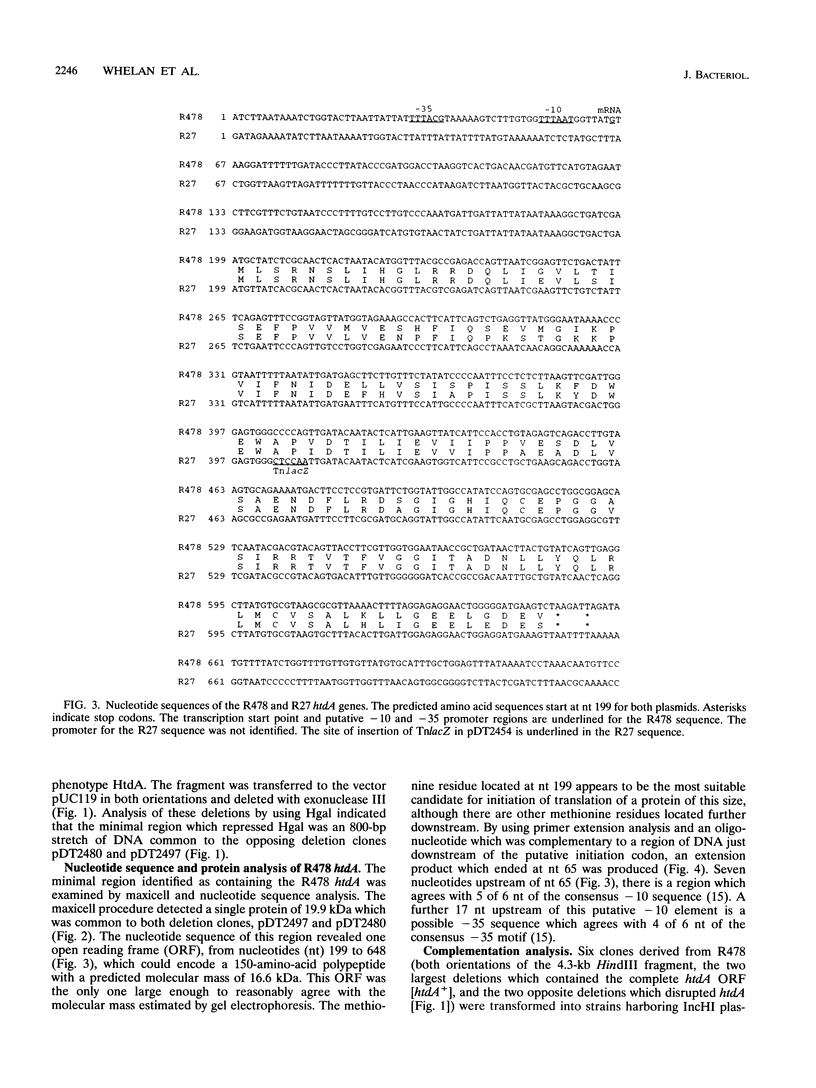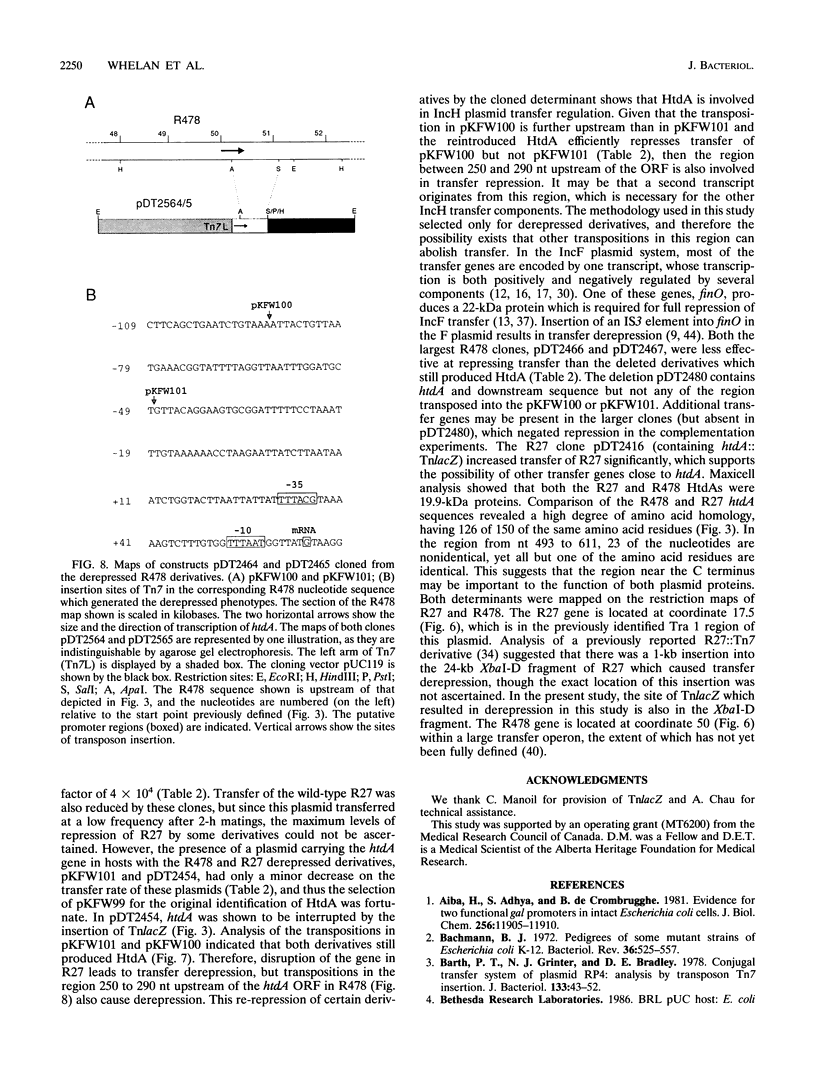Abstract
IncHI plasmids are naturally repressed for conjugative transfer and do not allow efficient propagation of the IncH pilus-specific phage Hgal. Transposons Tn7, Tn5, and TnlacZ were inserted into IncHI plasmids R478, R477-1, and R27, respectively, leading to the isolation of several plasmid mutants which exhibited increased levels of transfer and also permitted good lysis with phage Hgal. A 4.3-kb HindIII fragment from R478 reversed both phenotypic effects of derepression for the R477-1::Tn5 and the R478::Tn7 derivatives, pKFW99 and pKFW100, respectively. Exonuclease III deletions of this fragment and nucleotide sequence analysis indicated that the gene responsible for transfer repression, named here htdA, encoded a polypeptide of 150 amino acids. Cloning and sequence analysis of pDT2454 (R27::TnlacZ) revealed that the transposon had inserted into an open reading frame (ORF) which had an 83% amino acid identity with the R478 htdA gene. Maxicell analysis showed both the R27 and R478 HtdA products had molecular masses of 19.9 kDa. Conjugation experiments showed that the cloned htdA determinants caused a significant reduction of the transfer frequencies of wild-type R478 and R27 plasmids. Examination of both R478 derepressed mutants, pKFW100 and pKFW101, indicated that both transposon insertions occurred upstream of the htdA ORF. The results suggest that HtdA is a regulatory component of IncH plasmid transfer and also show that the region upstream of the htdA ORF is involved in transfer repression. The locations of the htdA determinants were identified on the plasmid maps of R27 and R478.
Full text
PDF









Images in this article
Selected References
These references are in PubMed. This may not be the complete list of references from this article.
- Aiba H., Adhya S., de Crombrugghe B. Evidence for two functional gal promoters in intact Escherichia coli cells. J Biol Chem. 1981 Nov 25;256(22):11905–11910. [PubMed] [Google Scholar]
- Bachmann B. J. Pedigrees of some mutant strains of Escherichia coli K-12. Bacteriol Rev. 1972 Dec;36(4):525–557. doi: 10.1128/br.36.4.525-557.1972. [DOI] [PMC free article] [PubMed] [Google Scholar]
- Barth P. T., Grinter N. J., Bradley D. E. Conjugal transfer system of plasmid RP4: analysis by transposon 7 insertion. J Bacteriol. 1978 Jan;133(1):43–52. doi: 10.1128/jb.133.1.43-52.1978. [DOI] [PMC free article] [PubMed] [Google Scholar]
- Birnboim H. C., Doly J. A rapid alkaline extraction procedure for screening recombinant plasmid DNA. Nucleic Acids Res. 1979 Nov 24;7(6):1513–1523. doi: 10.1093/nar/7.6.1513. [DOI] [PMC free article] [PubMed] [Google Scholar]
- Bradley D. E., Hughes V. M., Richards H., Datta N. R plasmids of a new incompatibility group determine constitutive production of H pili. Plasmid. 1982 May;7(3):230–238. doi: 10.1016/0147-619x(82)90004-x. [DOI] [PubMed] [Google Scholar]
- Bradley D. E. Morphological and serological relationships of conjugative pili. Plasmid. 1980 Sep;4(2):155–169. doi: 10.1016/0147-619x(80)90005-0. [DOI] [PubMed] [Google Scholar]
- Bradley D. E. The unique conjugation system of IncHI3 plasmid MIP233. Plasmid. 1986 Jul;16(1):63–71. doi: 10.1016/0147-619x(86)90080-6. [DOI] [PubMed] [Google Scholar]
- Cheah K. C., Skurray R. The F plasmid carries an IS3 insertion within finO. J Gen Microbiol. 1986 Dec;132(12):3269–3275. doi: 10.1099/00221287-132-12-3269. [DOI] [PubMed] [Google Scholar]
- Coetzee J. N., Bradley D. E., Fleming J., du Toit L., Hughes V. M., Hedges R. W. Phage pilH alpha: a phage which adsorbs to IncHI and IncHII plasmid-coded pili. J Gen Microbiol. 1985 May;131(5):1115–1121. doi: 10.1099/00221287-131-5-1115. [DOI] [PubMed] [Google Scholar]
- Dower W. J., Miller J. F., Ragsdale C. W. High efficiency transformation of E. coli by high voltage electroporation. Nucleic Acids Res. 1988 Jul 11;16(13):6127–6145. doi: 10.1093/nar/16.13.6127. [DOI] [PMC free article] [PubMed] [Google Scholar]
- Finlay B. B., Frost L. S., Paranchych W., Willetts N. S. Nucleotide sequences of five IncF plasmid finP alleles. J Bacteriol. 1986 Aug;167(2):754–757. doi: 10.1128/jb.167.2.754-757.1986. [DOI] [PMC free article] [PubMed] [Google Scholar]
- Frost L., Lee S., Yanchar N., Paranchych W. finP and fisO mutations in FinP anti-sense RNA suggest a model for FinOP action in the repression of bacterial conjugation by the Flac plasmid JCFL0. Mol Gen Genet. 1989 Jul;218(1):152–160. doi: 10.1007/BF00330578. [DOI] [PubMed] [Google Scholar]
- Gosti-Testu F., Norris V., Brevet J. Restriction map of Tn7. Plasmid. 1983 Jul;10(1):96–99. doi: 10.1016/0147-619x(83)90061-6. [DOI] [PubMed] [Google Scholar]
- Koraimann G., Koraimann C., Koronakis V., Schlager S., Högenauer G. Repression and derepression of conjugation of plasmid R1 by wild-type and mutated finP antisense RNA. Mol Microbiol. 1991 Jan;5(1):77–87. doi: 10.1111/j.1365-2958.1991.tb01828.x. [DOI] [PubMed] [Google Scholar]
- Laemmli U. K. Cleavage of structural proteins during the assembly of the head of bacteriophage T4. Nature. 1970 Aug 15;227(5259):680–685. doi: 10.1038/227680a0. [DOI] [PubMed] [Google Scholar]
- Maher D., Sherburne R., Taylor D. E. Bacteriophages for incompatibility group H plasmids: morphological and growth characteristics. Plasmid. 1991 Sep;26(2):141–146. doi: 10.1016/0147-619x(91)90055-2. [DOI] [PubMed] [Google Scholar]
- Maher D., Sherburne R., Taylor D. E. H-pilus assembly kinetics determined by electron microscopy. J Bacteriol. 1993 Apr;175(8):2175–2183. doi: 10.1128/jb.175.8.2175-2183.1993. [DOI] [PMC free article] [PubMed] [Google Scholar]
- Manoil C. Analysis of protein localization by use of gene fusions with complementary properties. J Bacteriol. 1990 Feb;172(2):1035–1042. doi: 10.1128/jb.172.2.1035-1042.1990. [DOI] [PMC free article] [PubMed] [Google Scholar]
- Newnham P. J., Taylor D. E. Genetic analysis of transfer and incompatibility functions within the IncHI plasmid R27. Plasmid. 1990 Mar;23(2):107–118. doi: 10.1016/0147-619x(90)90029-c. [DOI] [PubMed] [Google Scholar]
- Queen C., Korn L. J. A comprehensive sequence analysis program for the IBM personal computer. Nucleic Acids Res. 1984 Jan 11;12(1 Pt 2):581–599. doi: 10.1093/nar/12.1part2.581. [DOI] [PMC free article] [PubMed] [Google Scholar]
- Rodriguez-Lemoine V., Jacob A. E., Hedges R. W., Datta N. Thermosensitive production of their transfer systems by group S plasmids. J Gen Microbiol. 1975 Jan;86(1):111–114. doi: 10.1099/00221287-86-1-111. [DOI] [PubMed] [Google Scholar]
- Roussel A. F., Chabbert Y. A. Taxonomy and epidemiology of gram-negative bacterial plasmids studied by DNA-DNA filter hybridization in formamide. J Gen Microbiol. 1978 Feb;104(2):269–276. doi: 10.1099/00221287-104-2-269. [DOI] [PubMed] [Google Scholar]
- Sancar A., Hack A. M., Rupp W. D. Simple method for identification of plasmid-coded proteins. J Bacteriol. 1979 Jan;137(1):692–693. doi: 10.1128/jb.137.1.692-693.1979. [DOI] [PMC free article] [PubMed] [Google Scholar]
- Sanger F., Nicklen S., Coulson A. R. DNA sequencing with chain-terminating inhibitors. Proc Natl Acad Sci U S A. 1977 Dec;74(12):5463–5467. doi: 10.1073/pnas.74.12.5463. [DOI] [PMC free article] [PubMed] [Google Scholar]
- Silverman P. M., Wickersham E., Harris R. Regulation of the F plasmid traY promoter in Escherichia coli by host and plasmid factors. J Mol Biol. 1991 Mar 5;218(1):119–128. doi: 10.1016/0022-2836(91)90878-a. [DOI] [PubMed] [Google Scholar]
- Summers A. O., Jacoby G. A. Plasmid-determined resistance to tellurium compounds. J Bacteriol. 1977 Jan;129(1):276–281. doi: 10.1128/jb.129.1.276-281.1977. [DOI] [PMC free article] [PubMed] [Google Scholar]
- Taylor D. E., Brose E. C., Kwan S., Yan W. Mapping of transfer regions within incompatibility group HI plasmid R27. J Bacteriol. 1985 Jun;162(3):1221–1226. doi: 10.1128/jb.162.3.1221-1226.1985. [DOI] [PMC free article] [PubMed] [Google Scholar]
- Taylor D. E., Brose E. C. Restriction endonuclease mapping of R27 (TP117), an incompatibility group HI subgroup 1 plasmid from Salmonella typhimurium. Plasmid. 1985 Jan;13(1):75–77. doi: 10.1016/0147-619x(85)90058-7. [DOI] [PubMed] [Google Scholar]
- Taylor D. E., Levine J. G. Studies of temperature-sensitive transfer and maintenance of H incompatibility group plasmids. J Gen Microbiol. 1980 Feb;116(2):475–484. doi: 10.1099/00221287-116-2-475. [DOI] [PubMed] [Google Scholar]
- Taylor D. E., Summers A. O. Association of tellurium resistance and bacteriophage inhibition conferred by R plasmids. J Bacteriol. 1979 Mar;137(3):1430–1433. doi: 10.1128/jb.137.3.1430-1433.1979. [DOI] [PMC free article] [PubMed] [Google Scholar]
- Taylor D. E. Transfer-defective and tetracycline-sensitive mutants of the incompatibility group HI plasmid R27 generated by insertion of transposon 7. Plasmid. 1983 May;9(3):227–239. doi: 10.1016/0147-619x(83)90001-x. [DOI] [PubMed] [Google Scholar]
- Vieira J., Messing J. New pUC-derived cloning vectors with different selectable markers and DNA replication origins. Gene. 1991 Apr;100:189–194. doi: 10.1016/0378-1119(91)90365-i. [DOI] [PubMed] [Google Scholar]
- Vieira J., Messing J. The pUC plasmids, an M13mp7-derived system for insertion mutagenesis and sequencing with synthetic universal primers. Gene. 1982 Oct;19(3):259–268. doi: 10.1016/0378-1119(82)90015-4. [DOI] [PubMed] [Google Scholar]
- Whelan K. F., Colleran E. Restriction endonuclease mapping of the HI2 incompatibility group plasmid R478. J Bacteriol. 1992 Feb;174(4):1197–1204. doi: 10.1128/jb.174.4.1197-1204.1992. [DOI] [PMC free article] [PubMed] [Google Scholar]
- Whiteley M., Taylor D. E. Identification of DNA homologies among H incompatibility group plasmids by restriction enzyme digestion and Southern transfer hybridization. Antimicrob Agents Chemother. 1983 Aug;24(2):194–200. doi: 10.1128/aac.24.2.194. [DOI] [PMC free article] [PubMed] [Google Scholar]
- Yan W., Taylor D. E. Characterization of transfer regions within the HII incompatibility group plasmid pHH1508a. J Bacteriol. 1987 Jun;169(6):2866–2868. doi: 10.1128/jb.169.6.2866-2868.1987. [DOI] [PMC free article] [PubMed] [Google Scholar]
- Yoshioka Y., Ohtsubo H., Ohtsubo E. Repressor gene finO in plasmids R100 and F: constitutive transfer of plasmid F is caused by insertion of IS3 into F finO. J Bacteriol. 1987 Feb;169(2):619–623. doi: 10.1128/jb.169.2.619-623.1987. [DOI] [PMC free article] [PubMed] [Google Scholar]
- van Biesen T., Frost L. S. Differential levels of fertility inhibition among F-like plasmids are related to the cellular concentration of finO mRNA. Mol Microbiol. 1992 Mar;6(6):771–780. doi: 10.1111/j.1365-2958.1992.tb01527.x. [DOI] [PubMed] [Google Scholar]





